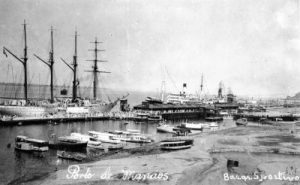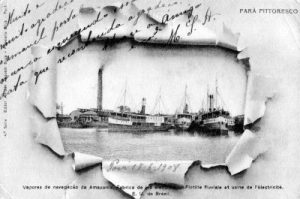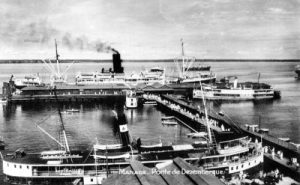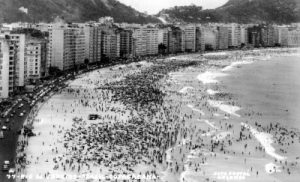TRAVEL IN THE SOUTH ATLANTIC
The main ports used by Portuguese emigration were the cities of Lisbon, on the Tagus River and Porto, on the Douro River. At the end of the 19th century, the port of Leixões was built, in the current city of Matosinhos, Porto district.
Until the 1950s, the trip was made by sailing boat, taking about 50 days to reach Rio de Janeiro.

Starting in 1851, using steam, this journey took only about 24 days.
If the steamer did not make any stopovers, the trip could have been made in 15 days, from Lisbon to Rio de Janeiro.
Emigration, in the first half of the 19th century, was limited to those who could afford the trip, whose global value was approximately 33$415 réis, which was the cost of the trip carried out in 1783 by João Pereira.
Travel expenses would be those that were made in 1783, in the city of Porto, with João Pereira, son of Inácio Pereira, by his compadre Domingos Lopes, on boarding to Rio de Janeiro, on the Navio Madre de Deus that left on the 13th. May 1783: for Contra Mestre, 24$000; a wooden box and lock, $870; come with everything, 3$220; two cheeses, $655; thatch $85 and soap $35, all $120; burlap for ash, $250; a blanket, 1$260; with boats that would take the box to the ship and go there a few times, $850; money given to John for expenses, $600; three regueifas (wheat bread, $210; two marmalade mallets, $280; half a hundred oranges, $400; two jars, $180; wine and brandy to fill them, $395; six lancets, $310; with the Galician to fetch the box and take it to the boat, $080; with customs fees, $180. Total expenses amount to 33$590 réis, with $175 réis being added to the expense account, totaling 33$415 réis. (Doc. Private archive – museum)

In order to understand the relative dimension of this importance, we present as a reference the “journa” or jeira” daily salary of a rural worker in the amount of $160 réis, requiring about 208 working days to finance the trip to Brazil.
Thus, if today the same daily work corresponds, in the same context, to around 40 euros, the cost of the trip would be around 8,320 euros.
In view of the travel expenses, we are faced with an impediment to generalized emigration, which explains the clandestine emigration and the selectivity of emigration to those who had available capital or the possibility of resorting to credit.

At the same time, the social capital that these rural landowners had in Portugal was enough to legitimize the fulfillment of implicitly established obligations and were inscribed in their own values of origin: seriousness, honor and word and gave meaning to the way in which were welcomed and well received in Brazil. These values were inscribed in references of social and family legitimacy, such as godparenting and patronage, reinforced in kinship ties, even if distant, thus explaining many of the marriages between “cousins”.
According to Leite Lage’s autobiographical account, the voyage from Porto to Rio de Janeiro , in 1827, would take about 60 days, including the mishaps resulting from the corsairs’ attacks .
Almost all of them, upon arrival in Rio de Janeiro or other Brazilian ports, were welcomed by a relative or neighbor installed in Brazil, who promoted their integration in the commercial activities of the destination, mainly as clerks, to whom they took a “letter of recommendation”. , as the aforementioned autobiography tells us .

Steamships had only three classes . Third class was intended for emigrants who were making their first trip. From 1920 onwards, many steamers or steamers, as they were called, came to have four classes: the first three had cabins and the last one was reserved for emigrants, where they came crowded, in stuffy, poorly lit, and generally overcrowded holds. , where poor hygiene conditions were evident.
Many laws were published requiring steamers to have certain conditions for travel. However, those obligations were rarely fulfilled by shipowners and ship captains.
At the end of the 19th century, the main ports of disembarkation in Brazil were the ports of Rio de Janeiro and Santos, in the State of São Paulo. Emigrants who entered Rio de Janeiro were housed at the Hospedaria da Ilha das Flores. Those who arrived in Santos stayed in the city or went directly to their destinations, being in most cases received by relatives or relatives who welcomed them on arrival.
With the inauguration of the Railway, in 1867, which connected Santos to Jundiaí, passing through São Paulo, transport began to be made by train, to the capital, disembarking the emigrants at the Hospedaria dos Emigrantes, in Brás, where they awaited their destination. .
The vast majority of Portuguese emigrants did not stay at the inn, as they were welcomed by relatives upon arrival at the port of Santos.
According to Leite Lage’s autobiographical account, the journey from Porto to Rio de Janeiro , in 1827, took about 60 days, including the mishaps resulting from the attacks of the corsairs .
Almost all of them, upon arrival in Rio de Janeiro or other Brazilian ports, were welcomed by a relative or neighbor installed in Brazil, who promoted their integration in the commercial activities of the destination, mainly as clerks, to whom they took a “letter of recommendation”. , as the aforementioned autobiography tells us .